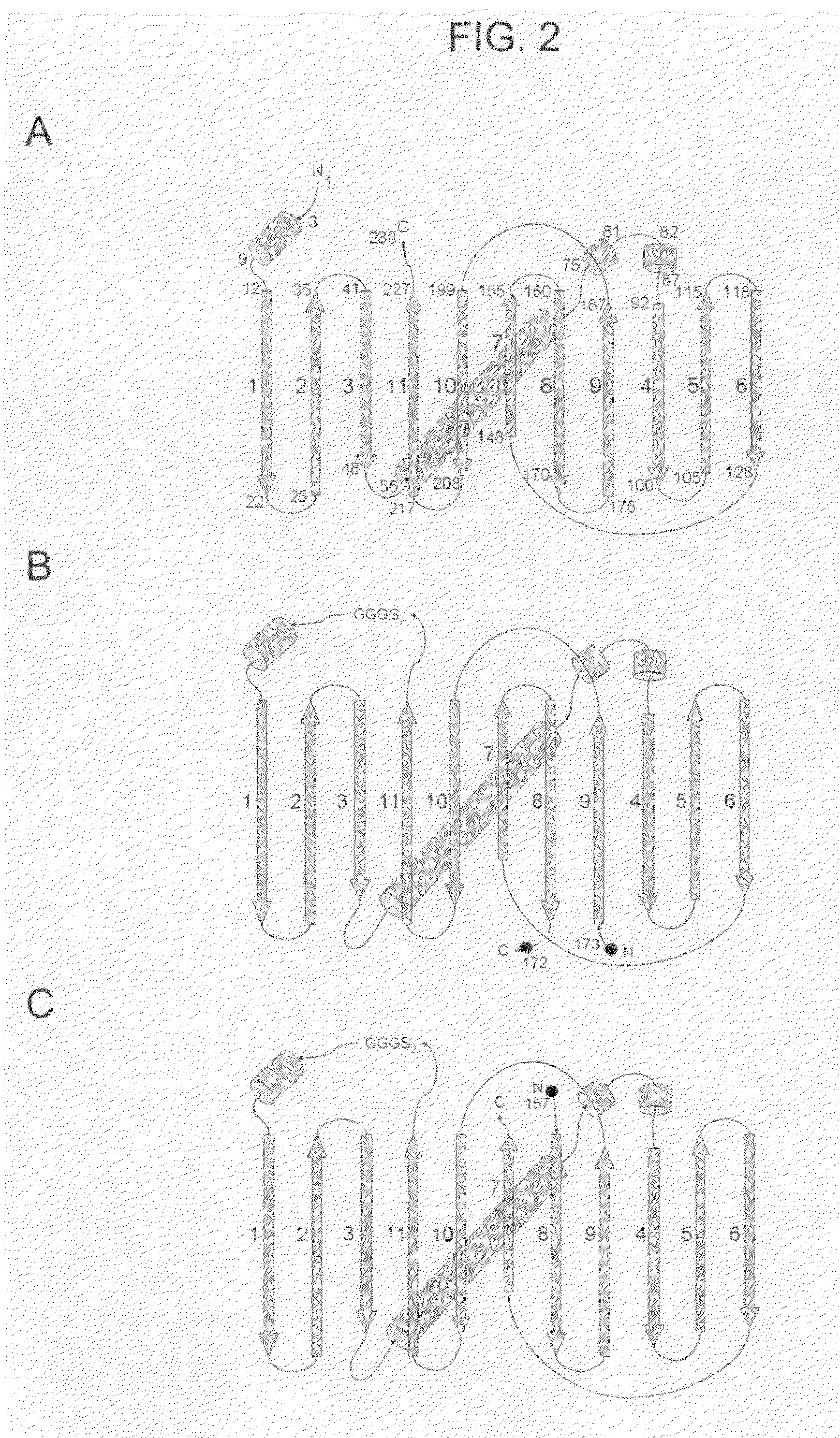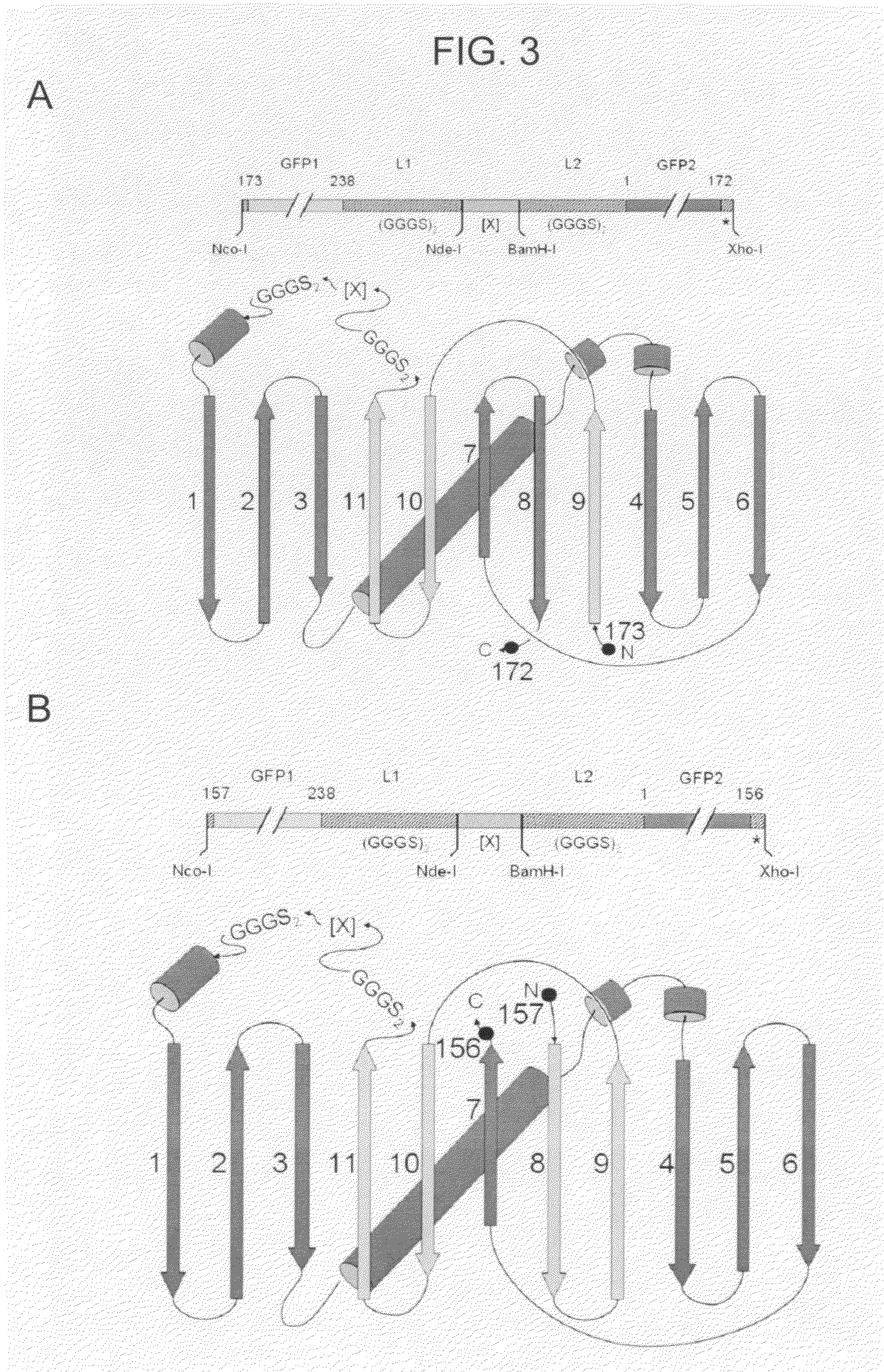Circular permutant GFP insertion folding reporters
a reporter and permutant technology, applied in the field of circular permutant gfp insertion folding reporter, can solve the problems of producing reduced or undetectable fluorescence levels, and achieve the effect of avoiding selection of false-positive truncated artifacts and little discrimination
- Summary
- Abstract
- Description
- Claims
- Application Information
AI Technical Summary
Benefits of technology
Problems solved by technology
Method used
Image
Examples
example 1
Generation of GFP Circular Permutants—Selection of Suitable Topologies
[0112]Circular permutants of superfolder GFP and folding reporter GFP variants were generated for each of eleven possible topologies, expressed in E. coli, and evaluated for folding / fluorescence as described (U.S. patent application Ser. Nos. 10 / 423,688 and 10 / 973,693). The GFP structure comprises an eleven-stranded beta barrel (see FIG. 2 A). Circular permutants of GFP were generated by ligating the coding sequences of the native N and C termini, and splicing in new translation start sites at eleven different positions between strands. The constructs and proteins encoded thereby were designated by the strands that begin and end the permutated sequence (i.e., 5′ coding / N-termini protein and 3′ coding / C-termini protein). Thus, for example, circular permutant GFPcp9 / 8 has strand 9 at the N-terminus and strand 8 at the C-terminus (i.e., amino acids 173 and 172 of the native GFP structure are, respectively, the N-term...
example 2
Engineering Variably Stringent GFP Insertion Vectors
[0114]Using the GFPcp9 / 8 and GFPcp8 / 7 topologies, four vectors corresponding to each topology were generated by combining domains from the two GFP variants, GFPSF and GFPFR (U.S. application Ser. Nos. 10 / 423,688 and 10 / 973,693). More specifically, for each topology, a cloning site was introduced between the native N and C-termini residue sequences dividing the GFP molecule into two domains. Two vectors were generated by using domains from the same GFP variant, while another two were generated by combining domains from the two variants (FIG. 4). These eight insertion GFP reporter constructs were evaluated for tolerance to inserted test proteins in E. coli (see EXAMPLE 3 infra, and FIG. 7).
[0115]For both the GFPcp9 / 8 and GFPcp8 / 7 topologies, the insertion GFP vectors display variable sensitivities to test protein misfolding (EXAMPLE 3, infra). Accordingly, the invention provides sets of insertion GFP reporters which enable protein fo...
example 3
GFP Insertion Vectors Display Variable Stringencies
[0117]The set of four GFP insertion vectors corresponding to each of the GFPcp9 / 8 and GFPcp8 / 7 circular permutant topologies were tested for sensitivity to test protein misfolding. Briefly, the coding sequences of four test proteins from the hyperthermophile Pyrobaculum aerophilum with known and variable solubilities were inserted into the vectors. Protein #1=sulfite reductase (dissimilatory subunit); #2=translation initiation factor; #3=3-hexylose 6-phosphate synthase; and 4=polysulfide reductase subunit (Waldo, G. S., Standish, B. M., Berendzen, J. & Terwilliger, T. C. Rapid protein-folding assay using green fluorescent protein. Nature Biotech. 17, 691-695 (1999)). Expressed alone #1 is fully soluble, #2 and #3 are partially soluble, and #4 is totally insoluble. Each of the vectors was tested by inserting the Pyrobaculum protein and expressing the colonies on nitrocellulose membranes on agar plates using IPTG as described (Waldo e...
PUM
 Login to View More
Login to View More Abstract
Description
Claims
Application Information
 Login to View More
Login to View More - R&D
- Intellectual Property
- Life Sciences
- Materials
- Tech Scout
- Unparalleled Data Quality
- Higher Quality Content
- 60% Fewer Hallucinations
Browse by: Latest US Patents, China's latest patents, Technical Efficacy Thesaurus, Application Domain, Technology Topic, Popular Technical Reports.
© 2025 PatSnap. All rights reserved.Legal|Privacy policy|Modern Slavery Act Transparency Statement|Sitemap|About US| Contact US: help@patsnap.com



